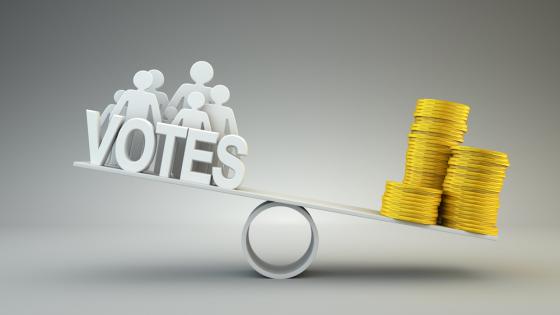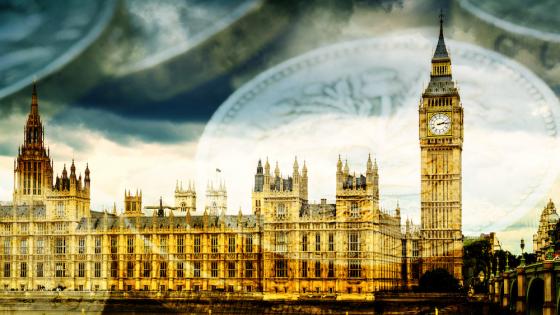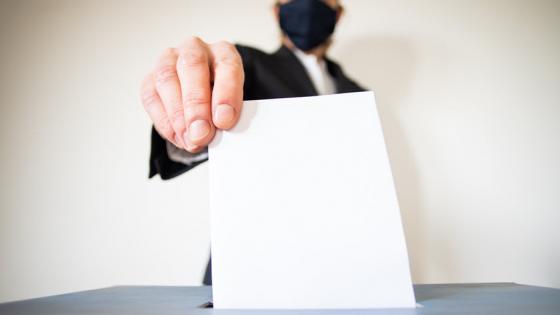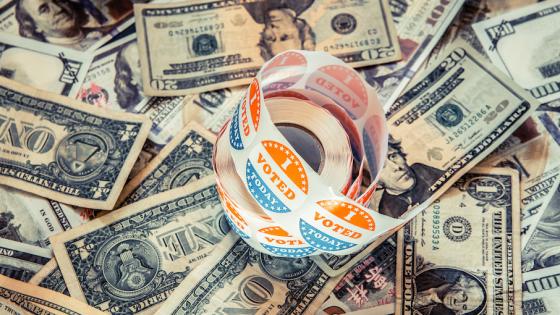Money’s influence on politics has long been the subject of debate.
This is particularly true in the US, where spending on federal elections has more than tripled in 20 years, from $4.6 billion in the 2000 federal election cycle (adjusted for inflation to 2020 US dollars) to $14.4 billion in 2020. But even in Europe, where campaign spending is far more modest, there are concerns about money distorting elections. Cagé and Dewitte (2022) show that in the UK, while spending in real terms has gone down over the last 150 years, the correlation between spending and winning has strengthened.
For over a century, but particularly since the 1960s, democracies around the world have instituted reforms to level their electoral playing fields. Some countries, including Brazil and the UK, have set mandatory spending limits. Others, including Canada, France, Italy, and South Korea, have combined spending limits with public reimbursement of campaign expenditures – the idea being that the cap may lower spending by well-resourced candidates while reimbursement can raise spending by poorer candidates. The US uses a system with more leeway: candidates for president (and for state office in 14 states) can choose either to comply with a spending limit and be reimbursed for expenses up to a certain amount, or not to comply and forgo the public funds. Barack Obama in 2008 became the first presidential candidate to opt out of public funding in order to spend unlimited sums, and all Democratic and Republican presidential nominees since then have done the same.
But what are the effects of these policies?
The theoretical literature generates two general, opposing predictions on the effects of campaign financing (see Stratmann 2005 for a review). Some studies suggest that higher spending can signal higher-quality candidates and enable broader dissemination of information vital to voters’ decision-making (e.g. Prat 2002, Coate 2004). Other studies suggest that higher spending gives candidates with access to more resources an unfair advantage, leading them to win elections even if they are not higher quality or more representative of voters’ preferences (Iaryczower and Mattozzi 2012, Pastine and Pastine 2012). Consistent with this literature is the concern that unregulated use of campaign money may lead to a wasteful arms race and facilitate the capture of the democratic process by wealthy individuals and interest groups (e.g. Baron 1994, Grossman and Helpman 1996).
While many papers have looked at how a candidate’s spending influences their chances of winning (e.g. Bekkouche and Cagé 2019), evidence on the causal impact of financial regulations is scarce. Indeed, these rules are usually enacted at the country level, limiting the variation available for credible estimates. Two recent papers using quasi-experimental designs find that spending caps reduce the incumbency advantage and increase competitiveness in Brazil (Avis et al. 2022) and the UK (Fouirnaies 2021).
These studies shed light on the effects of spending limits, but no experimental or quasi-experimental research to this point has given evidence on the effects of state reimbursement of campaign expenditures. This is an area of particular interest, since reimbursement policies might be considered the most ambitious widely implemented means to reduce money’s influence in elections.
In a new paper, three of us (Broberg, Tricaud, and Pons) look at the impact of campaign finance regulations in French local elections (Broberg et al. 2022). Using a regression discontinuity design (RDD), we examine electoral districts just above the population threshold of 9,000 inhabitants at which spending limits and reimbursements kick in, and compare them to electoral districts just below that threshold where there are no caps or reimbursements but other regulations are identical. The results indicate that campaign finance regulations in general – and state reimbursements of expenditures, in particular – can level the playing field and substantially decrease the incumbency advantage.
An effect, but from spending caps or reimbursements?
Local government in France includes different elected councils responsible for different areas of governance. Departmental councils exert responsibility over culture, local development, social assistance, education, housing, transportation, and tourism. They are made up of individual representatives of local electoral districts called cantons. In each district, the top candidate wins the race in the first round if they receive more than half the vote – otherwise, the top-two candidates in the first round go on to a second round, along with all other candidates above a certain vote share threshold.
Since the 1990s, all districts with over 9,000 residents have spending caps for departmental elections, but the limit depends on the size of the district. These caps are strictly enforced; violators can face prison time.
Spending limits apply to the total spending on the campaign (including contributions by supporters), but the reimbursements apply only to the candidate’s personal expenditures. What this means on the ground is that all candidates (or all those who can expect to get at least 5% of the vote) can spend up to half of the cap level with their own money and be reimbursed for it. Candidates can spend more – either with their own money or using donations from others – but they won't be reimbursed for it, and they must remain below the cap in any case.
We find that in French departmental elections:
1. Spending caps and the reimbursement of campaign expenditures make elections more competitive. The total number of candidates is unaffected, but the odds that any candidate obtains a majority of votes and wins the election in the first round decrease by 10.9 percentage points.
2. The regulations benefit those who have made unsuccessful bids in past elections, as well as newcomers to the political scene. The chances a previous runner-up wins the election increase by 5.2 percentage points, and the chances a candidate absent from the previous election wins increase by 9.2 percentage points. Overall, the incumbent’s re-election probability decreases by 14.5 percentage points. These effects result from incumbents being less likely to run for re-election, former challengers more likely to run, and incumbents being less likely – and challengers more likely – to win conditional on running.
3. Polarisation and representativeness of the results are unaffected by the regulations. Using a measure of right-left political orientation, we do not find that more extreme candidates are successful, or that winners are less representative of their constituents’ political preferences.
4. Left-wing candidates gain the most from the regulations. This is consistent with the fact that, before reimbursements were introduced, left-wing candidates received less than half of the amount of private donations received by right-wing candidates, making reimbursements particularly valuable to them.
These effects are pronounced, but do they result from the cap or the reimbursement? A quirk in how the regulations were instituted gives us some insight on this question.
The spending caps were introduced in electoral districts above 9,000 residents in 1990, but reimbursements of campaign expenditures were not introduced until 1995 (also in districts above 9,000 residents). That gives us the 1992 and 1994 elections to observe the effects of the caps alone.
We do not find any effect when we examine those elections, suggesting that our main effects are driven by the reimbursement of candidates more than expenditure ceilings. In the paper, we give further support for this interpretation based on the composition of candidates’ contributions before and after the introduction of reimbursements in 1995.
A more nuanced view of election reform
We also studied elections at the municipal level (the lowest tier of local governance in France) but found null effects of the regulations. There are a couple of potential reasons for this. Municipal elections use a list system where voters select not from individual candidates but from lists, including the mayoral candidate and the candidates for the municipal council. List voting and other proportional systems are common in Europe. They seek to ensure that parties have representation in government proportional to their membership among the population, giving smaller parties a boost they lack in the US, where plurality elections (also called majority or winner-take-all systems) seen in the departmental elections described above are nearly universal.
In the list system in French municipalities, campaign expenditures can be split across members of the list, so resources brought by fellow candidates may decrease the scope for public funding to make a difference. Also, incumbents are able to invite allies and rivals alike to join their list, which puts them in a more powerful position to withstand political parties pressuring them to stay out of the race.
All in all, we show that, in the French local system at least, campaign finance regulations, particularly state reimbursements of expenditures, can level the playing field and assist newcomers without decreasing the representativeness of elections. Our results suggest that this may be more true in plurality elections common in the US than in proportional elections more common in parliamentary systems.
Our results call for more research on reimbursements to better understand in which contexts they are most effective. The potential power of reimbursements to reduce the influence of money in elections is especially interesting given the complications entailed by setting spending caps – it is often hard to determine what limit would constrain well-resourced candidates enough to help outsiders.
For countries like the US, where one election cycle is quickly followed by fundraising for the next – and France, where access to even nonpecuniary resources is the subject of heated debate –a greater knowledge of which regulation can help level the playing field may ultimately strengthen democracy.
References
Avis, E, C Ferraz, F Finan, and C Varjao (2022), “Money and politics: The effects of campaign spending limits on political entry and competition”, American Economic Journal: Applied Economics, forthcoming.
Baron, D P (1994), “Electoral competition with informed and uninformed voters”, American Political Science Review 88(1): 33-47.
Bekkouche Y and J Cagé (2019), “How money can turn electoral results upside down”, VoxEU.org, 14 September.
Broberg, N, V Pons, and C Tricaud (2022), “The impact of campaign finance rules on candidate selection and electoral outcomes: Evidence from France”, NBER Working Paper 29805.
Cagé, J, and E Dewitte (2022), “The persistent role of money in UK politics”, VoxEU.org, 4 February.
Coate, S (2004), “Pareto-improving campaign finance policy”, American Economic Review 94(3): 628-655.
Fouirnaies, A (2021), “How do campaign spending limits affect elections? Evidence from the United Kingdom 1885–2019”, American Political Science Review 115(2): 395–411.
Grossman, G M and E Helpman (1996), “Electoral competition and special interest politics”, The Review of Economic Studies 63(2): 265-286.
Iaryczower, M, and A Mattozzi (2012), “The pro-competitive effect of campaign limits in non-majoritarian elections”, Economic Theory 49(3): 591–619.
Pastine, I and T Pastine (2012), “Incumbency advantage and political campaign spending limits”, Journal of Public Economics 96(1-2): 20–32.
Prat, A (2002), “Campaign advertising and voter welfare”, The Review of Economic Studies 69(4): 999-1017.
Stratmann, T (2005), “Some talk: Money in politics. a (partial) review of the literature”, Policy challenges and political responses, 135–156.








